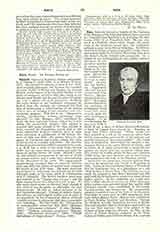
Giovanni Battista Riccioli
Italian astronomer, b. at Ferrara April 17, 1598; d. at Bologna June 25, 1671

Riccioli, GIOVANNI BATTISTA, Italian astronomer, b. at Ferrara April 17, 1598; d. at Bologna June 25, 1671. He entered the Society of Jesus October 6, 1614. After teaching philosophy and theology for a number of years, chiefly at Parma and Bologna, he devoted himself, at the request of his superiors, entirely to the study of astronomy, which at that time, owing to the discoveries of Kepler and the new theories of Copernicus, was a subject of much discussion. Realizing the many defects of the traditional astronomy inherited from the ancients, he conceived the bold idea of undertaking a reconstruction of the science with a view to bringing it into harmony with contemporary progress. This led to his “Almagestum novum, astronomiam veterem novamque cornplectens” (2 vols., Bologna, 1651), considered by many the most important literary work of the Jesuits during the seventeenth century. The author in common with many scholars of the time, notably in Italy, rejected the Copernican theory, and in this work, admittedly of great erudition, gives an elaborate refutation in justification of the Roman Decrees of 1616 and 1633. He praises, however, the genius of Copernicus and readily admits the value of his system as a simple hypothesis. His sincerity in this connection has been called into question by some, e.g. Wolf, but a study of the work shows beyond doubt that he wrote from conviction and with the desire of making known the truth. Riccioli’s project also included a comparison of the unit of length of various nations and a more exact determination of the dimensions of the earth. His topographical measurements occupied him at intervals between 1644 and 1656, but defects of method have rendered his results of but little value. His most important contribution to astronomy was perhaps his detailed telescopic study of the moon, made in collaboration with P. Grimaldi. The latter’s excellent lunar map was inserted in the “Almagestum novum”, and the lunar nomenclature they adopted is still in use. He also made observations on Saturn’s rings, though it was reserved for Huyghens to determine the true ring-structure. He was an ardent defender of the new Gregorian calendar. Though of delicate health, Riccioli was an indefatigable worker and, in spite of his opposition to the Copernican theory, rendered valuable services to astronomy and also to geography and chronology. His chief works are: “Geographiae et hydrographiae reformatae libri XII” (Bologna, 1661); “Astronomia reformata” (2 vols., Bologna, 1665); “Vindiciae calendarii gregoriani” (Bologna, 1666); “Chronologia reformata” (1669); “Tabula latitudinum et longitudinum” (Vienna, 1689).
H. M. BROOK

